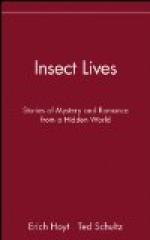Such a butterfly as we have briefly sketched lays an egg on the leaf of some suitable food-plant, and there is hatched from it the well-known crawling larva[1] (fig. 1 b, c, d) called a caterpillar, offering in many superficial features a marked contrast to its parent. Except on the head, whose surface is hard and firm, the caterpillar’s cuticle is as a rule thin and flexible, though it may carry a protective armature of closely set hairs, or strong sharp spines. The feelers (fig. 3 At) are very short and the eyes are small and simple. In connection with the mouth, there are present in front of the maxillae a pair of mandibles (fig. 3 Mn), strong jaws, adapted for biting solid food, which are absent from the adult butterfly, though well developed in cockroaches, dragon-flies, beetles, and many other insects. The three pairs of legs on the segments of the thorax are relatively short, and as many as five segments of the abdomen may carry short cylindrical limbs or pro-legs, which assist the clinging habits and worm-like locomotion of the caterpillar. No trace of wings is visible externally. The caterpillar, therefore, differs markedly from its parent in its outward structure, in its mode of progression, and in its manner of feeding; for while the butterfly sucks nectar or other liquid food, the caterpillar bites up and devours solid vegetable substances, such as the leaves of herbs or trees. It is well-known that between the close of its larval life and its attainment of perfection as a butterfly, the insect spends a period as a pupa (fig. 1 e) unable to move from place to place, and taking no food.
[1] The term larva is applied to any young animal which differs markedly from its parent.
[Illustration: Fig. 3. Head of Caterpillar of Goat-moth (Cossus) seen from behind. At, feeler; Mn, mandible; Mx, maxilla; Lm, labium, spinneret projecting beyond it. Magnified. After Lyonet from Miall and Denny’s Cockroach.]
Such, in brief, is the course of the most familiar of insect life-stories. For the student of the animal world as a whole, this familiar transformation raises some startling problems, which have been suggestively treated by F. Brauer (1869), L.C. Miall (1895), J. Lubbock (1874), R. Heymons (1907), P. Deegener (1909) and other writers[2]. To appreciate these problems is the first step towards learning the true meaning of the transformation.
[2] The dates in brackets after authors’ names will facilitate reference to the Bibliography (pp. 124-8).




